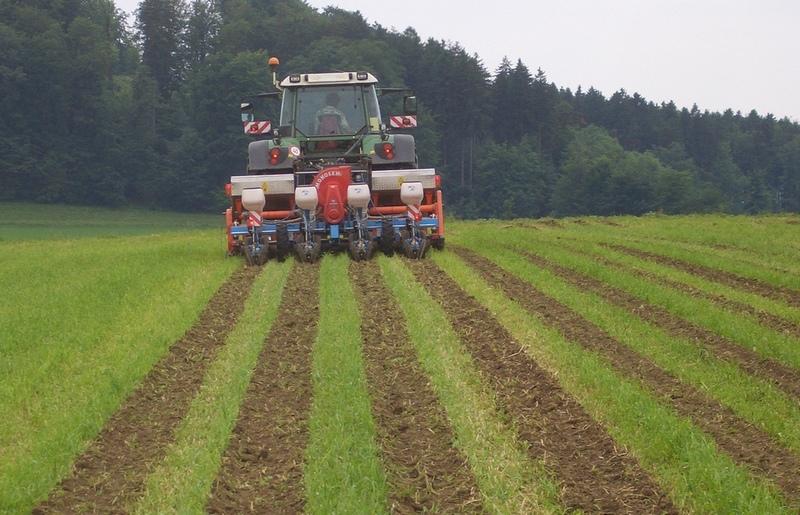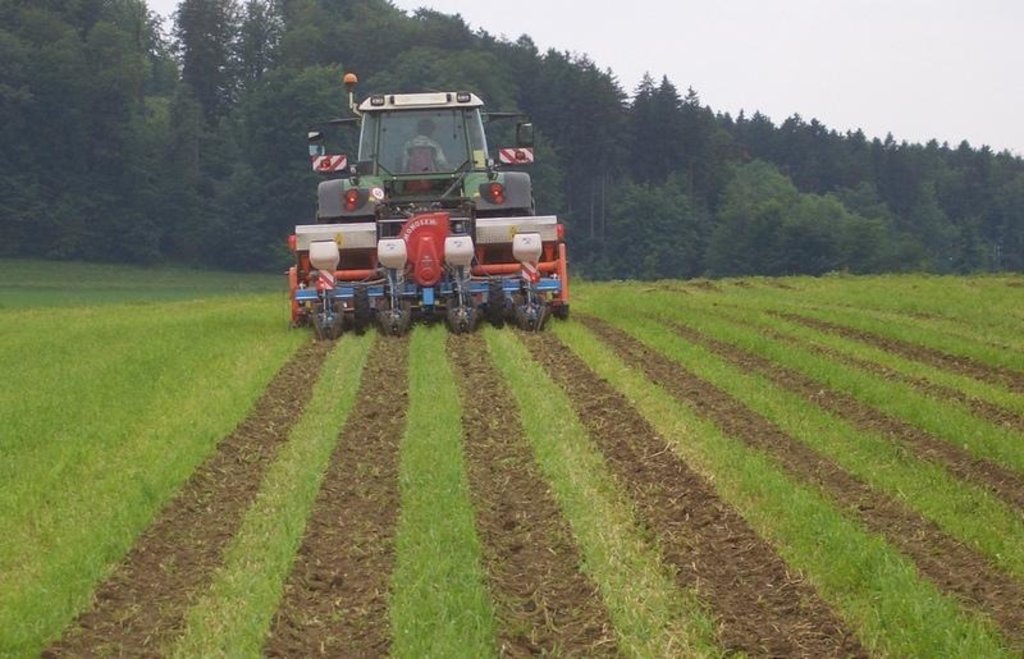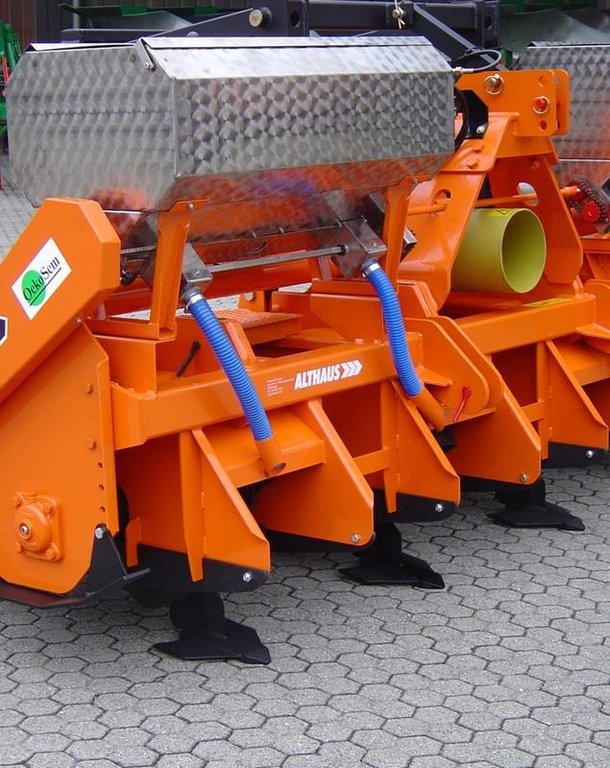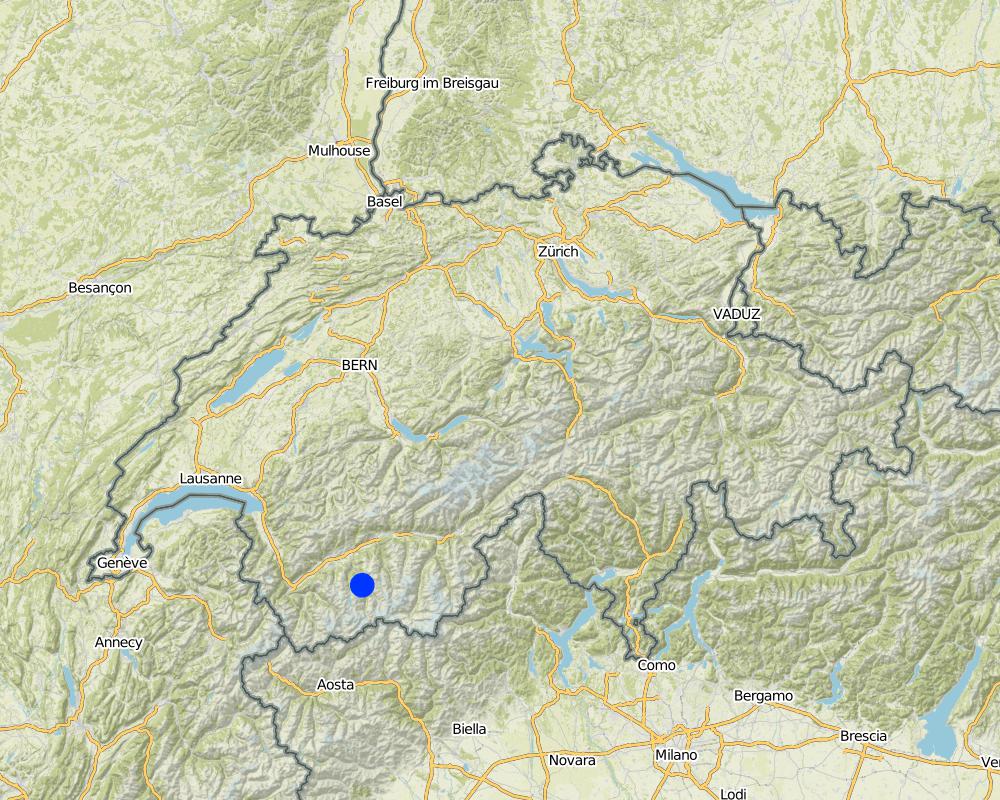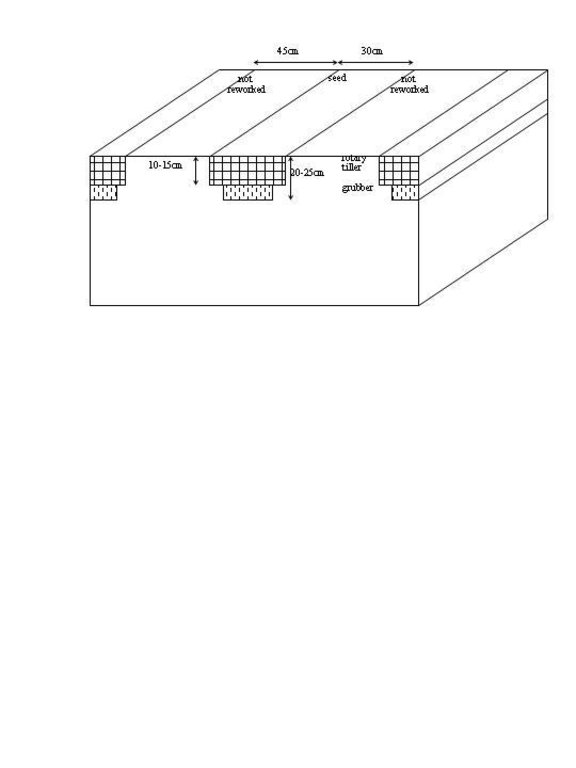Maize strip tillage [Suisse]
- Création :
- Mise à jour :
- Compilateur : Unknown User
- Rédacteur : –
- Examinateurs : Fabian Ottiger, Alexandra Gavilano
Streifenfrässaat (German)
technologies_1006 - Suisse
Voir les sections
Développer tout Réduire tout1. Informations générales
1.2 Coordonnées des personnes-ressources et des institutions impliquées dans l'évaluation et la documentation de la Technologie
Personne(s)-ressource(s) clé(s)
Spécialiste GDT:
Wyler Roman
Center for Development and Environment, University of Berne
Suisse
exploitant des terres:
Wyss Beat
Suisse
Nom du ou des institutions qui ont facilité la documentation/ l'évaluation de la Technologie (si pertinent)
CDE Centre for Development and Environment (CDE Centre for Development and Environment) - Suisse1.3 Conditions relatives à l'utilisation par WOCAT des données documentées
Le compilateur et la(les) personne(s) ressource(s) acceptent les conditions relatives à l'utilisation par WOCAT des données documentées:
Oui
1.5 Référence au(x) Questionnaires sur les Approches de GDT (documentées au moyen de WOCAT)
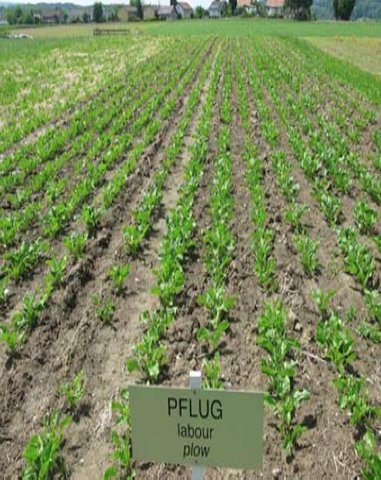
Soil support program for conservation agriculture [Suisse]
Through the soil support program land users get subsidies for applying conservation technologies on their fields during a period of 6 years.
- Compilateur : Deborah Niggli
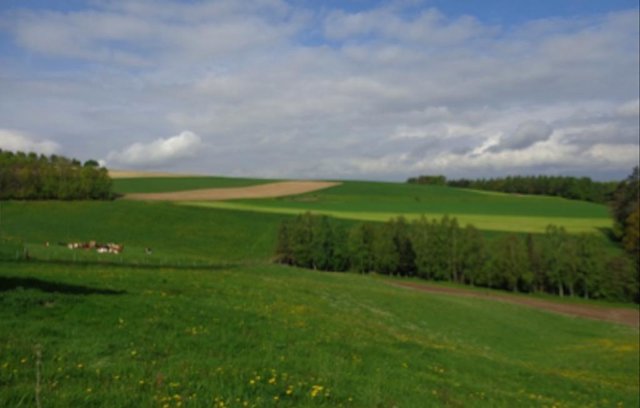
Direktzahlungssystem [Suisse]
Finanzielle Leistungen des Bundes um den Ertragsverlust, den eine Kultur für den Bauern bringt, auszugleichen. Das Direktzahlungssystem führt gewissermassen zu einer 'Vergünstigung des Produkts' für den Konsumenten.
- Compilateur : Deborah Niggli
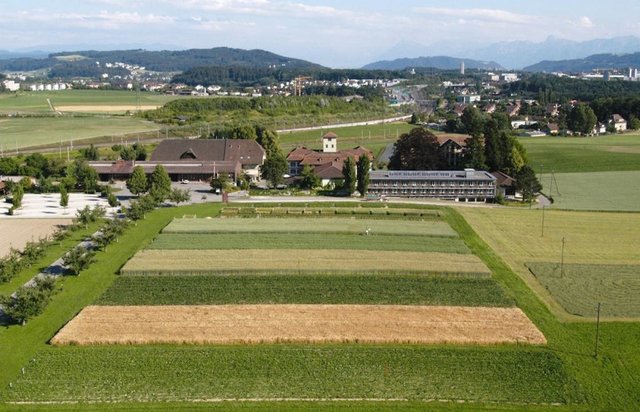
Förderprogramm Boden [Suisse]
Mit dem Förderprogramm Boden des Kantons Bern erhalten beteiligte Landnutzer Direktzahlungen für die Anwendung von bodenkonservierenden Anbauverfahren auf ihren landwirtschaftlichen Feldern. Das Projekt hat eine Dauer von 6 Jahren.
- Compilateur : Deborah Niggli
2. Description de la Technologie de GDT
2.1 Courte description de la Technologie
Définition de la Technologie:
A cropping system for maize which reduces the reworking of the soil to the stripes, in which the seeds are planted.
2.2 Description détaillée de la Technologie
Description:
Maize strip tillage is a mixture between no tillage and conventional agriculture. The reworking of the soil greatly reduced. Instead of ploughing and harrowing a special rotary tiller including a grubber is being used. The working depht of the rotary tiller is 10-15cm, the grubber reaches to 20-25cm depht. The machine reworks the soil on stripes of 30cm width. This is where the seeds are planted. In between there are stripes of 45cm width, which are left untouched.
In Switzerland farms usually are small. A major part of the arable land is used to produce fodder. (For example maize, grain, fodder beet)
Usually maize strip tillage is being used to avoid soil erosion or for economical reasons. Compared to conventional agriculture several working steps can be saved. The reworking of the soil, manuring, seeding and applying of herbicides can be done at once.
Since the machine is expensive and a strong tractor is needed, farmers usually don’t buy it on their own. In most cases a contractor will be tasked to do this work. Of course this is not for free. But since several working step are saved, there is more time left to do other work (6.5h/ha).
The reduced reworking of the soil holds remarkable ecological advantages. Occurrence of erosion is very seldom, because the stripes covered by plant residual significantly reduce the speed of surface water. To increase this effect, the stripes are laid along the height countours, if possible. Since the soil structure is not disturbed in the stripes between the seeds, the risk of compaction is reduced there. For that reason maize strip tillage is often used before potatoes in a crop rotation. This is a crop that is very sensitive to soil compaction.
The technique brings along an ecological disadvantage, too. Before sowings the precedent crop needs to be treated with a total herbicide (glyphosat) to avoid unwanted competition. Only in wet areas, where there is enough water available it is possible to not use glyphosat. Also in long time studies, residues of glyphosat could not be detected in the soil. But if ever weeds will develop a resitance against it, that would certainly be a major problem.
The enhanced risk of crop loss is another disadvantage of the technology. In conventional agriculture the soil is left to dry for a few days after ploughing. maize strip tillage does not hold that possibility. If the conditions are wet, risk of crop failure can be a problem. However, if conditions are good (dry enough), both quality and crop yield are similar to conventional agriculture.
2.3 Photos de la Technologie
2.5 Pays/ région/ lieux où la Technologie a été appliquée et qui sont couverts par cette évaluation
Pays:
Suisse
Région/ Etat/ Province:
Kanton Solothurn
Autres spécifications du lieu:
Oberramsern
Commentaires:
The portraited farmer is working as a contractor and is applying the technology on about 0.8km2. Currently only 1ha of his own land is used for maize.
Map
×2.6 Date de mise en œuvre de la Technologie
Si l'année précise est inconnue, indiquez la date approximative: :
- il y a entre 10-50 ans
2.7 Introduction de la Technologie
Spécifiez comment la Technologie a été introduite: :
- grâce à l'innovation d'exploitants des terres
Commentaires (type de projet, etc.) :
The technology was developed some 12years ago by the designer and contractor Walter Witzig supported by researchers from Forschungsanstalt Reckenholz-Tänikon.
3. Classification de la Technologie de GDT
3.1 Principal(aux) objectif(s) de la Technologie
- réduire, prévenir, restaurer les terres dégradées
3.2 Type(s) actuel(s) d'utilisation des terres, là où la Technologie est appliquée

Terres cultivées
- Cultures annuelles
- Cultures pérennes (non ligneuses)
- hay
Cultures annuelles - Précisez les cultures:
- céréales - maïs
Nombre de période de croissance par an: :
- 1
Précisez:
Longest growing period in days: 240Longest growing period from month to month: Mar - Oct
Commentaires:
Major land use problems (land users’ perception): Soil erosion by water and soil compaction.
3.4 Approvisionnement en eau
Approvisionnement en eau des terres sur lesquelles est appliquée la Technologie:
- pluvial
3.5 Groupe de GDT auquel appartient la Technologie
- mesures en travers de la pente
3.6 Mesures de GDT constituant la Technologie

pratiques agronomiques
- A1: Couverture végétale/ du sol
Commentaires:
Main measures: agronomic measures
Type of agronomic measures: contour planting / strip cropping, minimum tillage
3.7 Principaux types de dégradation des terres traités par la Technologie

érosion hydrique des sols
- Wt: perte de la couche superficielle des sols (couche arable)/ érosion de surface

dégradation physique des sols
- Pc: compaction

dégradation biologique
- Bc: réduction de la couverture végétale
- Bl: perte de la vie des sols
Commentaires:
Main type of degradation addressed: Wt: loss of topsoil / surface erosion, Pc: compaction, Bc: reduction of vegetation cover
Secondary types of degradation addressed: Bl: loss of soil life
Main causes of degradation: crop management (annual, perennial, tree/shrub) (too deep and too intensive reworking of the soil.), Heavy / extreme rainfall (intensity/amounts), education, access to knowledge and support services (Tradition. Most people do not question tillage.), crop management (annual, perennial, tree / shrub) (too heavy machinery used under wet conditions.)
3.8 Prévention, réduction de la dégradation ou réhabilitation des terres dégradées
Spécifiez l'objectif de la Technologie au regard de la dégradation des terres:
- prévenir la dégradation des terres
- réduire la dégradation des terres
Commentaires:
Main goals: prevention of land degradation
Secondary goals: mitigation / reduction of land degradation
4. Spécifications techniques, activités, intrants et coûts de mise en œuvre
4.1 Dessin technique de la Technologie
Spécifications techniques (associées au dessin technique):
The rotary tillers working depth is 10-15cm. The grubber reaches to 20-25cm depth. This is to obtain a loose soil structure. Manure is brought into the soil while tilling.
Immediately after that the seeds are brought into the soil. Finally a selective herbicide can be sprayed. Stripes of 45cm width are not reworked and help to avoid soil erosion and compaction.
Technical knowledge required for field staff / advisors: moderate
Technical knowledge required for land users: moderate
Main technical functions: improvement of ground cover, improvement of topsoil structure (compaction)
Secondary technical functions: control of raindrop splash, improvement of surface structure (crusting, sealing), increase of infiltration, increase / maintain water stored in soil
Contour planting / strip cropping
Material/ species: Maize
Minimum tillage
Remarks: The stripes are laid along the contours
Auteur:
Roman Wyler, Bern, Switzerland
4.2 Informations générales sur le calcul des intrants et des coûts
autre/ monnaie nationale (précisez):
Swiss Franc
Indiquez le taux de change des USD en devise locale, le cas échéant (p.ex. 1 USD = 79.9 réal brésilien): 1 USD = :
1,13
4.3 Activités de mise en place/ d'établissement
| Activité | Calendrier des activités (saisonnier) | |
|---|---|---|
| 1. | Buy a "Streifenfräse" | |
| 2. | Buy a tractor |
4.4 Coûts et intrants nécessaires à la mise en place
| Spécifiez les intrants | Unité | Quantité | Coûts par unité | Coût total par intrant | % des coût supporté par les exploitants des terres | |
|---|---|---|---|---|---|---|
| Equipements | Streifenfräse | Machine | 1,0 | 42000,0 | 42000,0 | 100,0 |
| Equipements | Tractor | Machine | 1,0 | 115000,0 | 115000,0 | 100,0 |
| Coût total de mise en place de la Technologie | 157000,0 | |||||
| Coût total de mise en place de la Technologie en dollars américains (USD) | 138938,05 | |||||
Commentaires:
Duration of establishment phase: 0 month(s)
4.5 Activités d'entretien/ récurrentes
| Activité | Calendrier/ fréquence | |
|---|---|---|
| 1. | application of glyphosat (total herbicide) | 1 per growing period |
| 2. | tillage of stripes including seeding, manuring, spraying of herbicide | 1 per growing period |
4.6 Coûts et intrants nécessaires aux activités d'entretien/ récurrentes (par an)
| Spécifiez les intrants | Unité | Quantité | Coûts par unité | Coût total par intrant | % des coût supporté par les exploitants des terres | |
|---|---|---|---|---|---|---|
| Main d'œuvre | tillage of stripes, seeding, | ha | 1,0 | 393,0 | 393,0 | 100,0 |
| Main d'œuvre | appliance of total herbicide | ha | 1,0 | 88,0 | 88,0 | 100,0 |
| Engrais et biocides | Biocides | ha | 1,0 | 53,0 | 53,0 | 100,0 |
| Coût total d'entretien de la Technologie | 534,0 | |||||
| Coût total d'entretien de la Technologie en dollars américains (USD) | 472,57 | |||||
Commentaires:
Crop yield is about the same as in conventional cropping systems. The cost to apply the technology are about $410 per ha. It takes about 2 working hours per ha. In addition the glyphosat needs to be applied, which accounts for $150 or 0.75h of work. The following worksteps are not needed anymore (working hours, costs when tasking a contractor excl. material): Ploughing (1.25h, $260), harrowing (1.25h, $180), conventional seeding (1h, $100), manuring (1h, $50), applying of herbicides (0.75h, $90). In total about $130 and 4 hours of work can be saved per ha. In some cantons Streifenfrässaat is also subsidised. In the canton of bern this accounts for $420 per ha and year for the first 5 years of appliance. The costs for manure, herbicides, seeds are not included since they are the same as in conventional agriculture.
4.7 Facteurs les plus importants affectant les coûts
Décrivez les facteurs les plus importants affectant les coûts :
The machine is very expensive. In addition a strong tractor is needed (ca. 150hp). Thats why most farmer task a contractor with the seeding. In this case no initial investment needs to be done. The machine in this case study is used for about 60ha per year. A bigger workload would be possible.
5. Environnement naturel et humain
5.1 Climat
Précipitations annuelles
- < 250 mm
- 251-500 mm
- 501-750 mm
- 751-1000 mm
- 1001-1500 mm
- 1501-2000 mm
- 2001-3000 mm
- 3001-4000 mm
- > 4000 mm
Zone agro-climatique
- subhumide
Thermal climate class: temperate
5.2 Topographie
Pentes moyennes:
- plat (0-2 %)
- faible (3-5%)
- modéré (6-10%)
- onduleux (11-15%)
- vallonné (16-30%)
- raide (31-60%)
- très raide (>60%)
Reliefs:
- plateaux/ plaines
- crêtes
- flancs/ pentes de montagne
- flancs/ pentes de colline
- piémonts/ glacis (bas de pente)
- fonds de vallée/bas-fonds
Zones altitudinales:
- 0-100 m
- 101-500 m
- 501-1000 m
- 1001-1500 m
- 1501-2000 m
- 2001-2500 m
- 2501-3000 m
- 3001-4000 m
- > 4000 m
5.3 Sols
Profondeur moyenne du sol:
- très superficiel (0-20 cm)
- superficiel (21-50 cm)
- modérément profond (51-80 cm)
- profond (81-120 cm)
- très profond (>120 cm)
Texture du sol (de la couche arable):
- moyen (limoneux)
- fin/ lourd (argile)
Matière organique de la couche arable:
- abondant (>3%)
Si disponible, joignez une description complète du sol ou précisez les informations disponibles, par ex., type de sol, pH/ acidité du sol, capacité d'échange cationique, azote, salinité, etc.
Soil fertility is high
Soil drainage/infiltration is good
Soil water storage capacity is high
5.4 Disponibilité et qualité de l'eau
Profondeur estimée de l’eau dans le sol:
5-50 m
Qualité de l’eau (non traitée):
eau potable
Commentaires et précisions supplémentaires sur la qualité et la quantité d'eau:
Availability of surface water: good, medium ( precipitation maximum in summer )
5.5 Biodiversité
Diversité des espèces:
- moyenne
5.6 Caractéristiques des exploitants des terres appliquant la Technologie
Orientation du système de production:
- commercial/ de marché
Revenus hors exploitation:
- > 50% de tous les revenus
Niveau relatif de richesse:
- moyen
Individus ou groupes:
- individu/ ménage
Niveau de mécanisation:
- mécanisé/ motorisé
Indiquez toute autre caractéristique pertinente des exploitants des terres:
Difference in the involvement of women and men: Ist mostly men that get in touch with the technology since it is mostly them who are using the machines. But decisions about which technology should be used are taken at the household level including both women and men.
Population density: 50-100 persons/km2
Annual population growth: 0.5% - 1%
Off-farm income specification: The farmer interviewed is working for other farmers, too. In general off-farm income is significantly lower.
5.7 Superficie moyenne des terres utilisées par les exploitants des terres appliquant la Technologie
- < 0,5 ha
- 0,5-1 ha
- 1-2 ha
- 2-5 ha
- 5-15 ha
- 15-50 ha
- 50-100 ha
- 100-500 ha
- 500-1 000 ha
- 1 000-10 000 ha
- > 10 000 ha
Commentaires:
The farmer portraited owns not more than 10ha, he is working for others as a contractor
5.8 Propriété foncière, droits d’utilisation des terres et de l'eau
Propriété foncière:
- individu, avec titre de propriété
Droits d’utilisation des terres:
- individuel
Droits d’utilisation de l’eau:
- communautaire (organisé)
5.9 Accès aux services et aux infrastructures
santé:
- pauvre
- modéré
- bonne
éducation:
- pauvre
- modéré
- bonne
assistance technique:
- pauvre
- modéré
- bonne
emploi (par ex. hors exploitation):
- pauvre
- modéré
- bonne
marchés:
- pauvre
- modéré
- bonne
énergie:
- pauvre
- modéré
- bonne
routes et transports:
- pauvre
- modéré
- bonne
eau potable et assainissement:
- pauvre
- modéré
- bonne
services financiers:
- pauvre
- modéré
- bonne
6. Impacts et conclusions
6.1 Impacts sur site que la Technologie a montrés
Impacts socio-économiques
Production
production agricole
Commentaires/ spécifiez:
steeper hills can be cultivated since the risk for erosion is reduced
qualité des fourrages
risque d'échec de la production
Commentaires/ spécifiez:
droughts: less water scarcity, intense rain: less erosion but the weather needs to be dryer in spring, since the soil cannot be left to dry between ploughing and seeding
surface de production
Revenus et coûts
dépenses pour les intrants agricoles
Commentaires/ spécifiez:
Less worksteps need to be done, income remains the same. But a total herbicide and sometimes a little more manure is needed
diversité des sources de revenus
Commentaires/ spécifiez:
Since the work is usually outsourced to a contractor, the farmer can use his time for other activities
charge de travail
Commentaires/ spécifiez:
less worksteps need to be done
Impacts socioculturels
opportunités culturelles
Commentaires/ spécifiez:
Reduced independence if contractors are tasked
Impacts écologiques
Sols
couverture du sol
perte en sol
encroûtement/ battance du sol
compaction du sol
Biodiversité: végétale, animale
espèces bénéfiques
Commentaires/ spécifiez:
more earthworms
6.2 Impacts hors site que la Technologie a montrés
dommages sur les champs voisins
dommages sur les infrastructures publiques/ privées
6.3 Exposition et sensibilité de la Technologie aux changements progressifs et aux évènements extrêmes/catastrophes liés au climat (telles que perçues par les exploitants des terres)
Changements climatiques progressifs
Changements climatiques progressifs
| Saison | Augmentation ou diminution | Comment la Technologie fait-elle face à cela? | |
|---|---|---|---|
| températures annuelles | augmente | pas connu |
Extrêmes climatiques (catastrophes)
Catastrophes météorologiques
| Comment la Technologie fait-elle face à cela? | |
|---|---|
| pluie torrentielle locale | bien |
| tempête de vent locale | pas connu |
Catastrophes climatiques
| Comment la Technologie fait-elle face à cela? | |
|---|---|
| sécheresse | bien |
Catastrophes hydrologiques
| Comment la Technologie fait-elle face à cela? | |
|---|---|
| inondation générale (rivière) | pas connu |
Autres conséquences liées au climat
Autres conséquences liées au climat
| Comment la Technologie fait-elle face à cela? | |
|---|---|
| réduction de la période de croissance | pas bien |
6.4 Analyse coûts-bénéfices
Quels sont les bénéfices comparativement aux coûts de mise en place (du point de vue des exploitants des terres)?
Rentabilité à court terme:
négative
Rentabilité à long terme:
positive
Quels sont les bénéfices comparativement aux coûts d'entretien récurrents (du point de vue des exploitants des terres)?
Rentabilité à court terme:
positive
Rentabilité à long terme:
positive
Commentaires:
The farmer portaited bought a machine on his own. If a contractor were tasked short-returns would be positive too.
6.5 Adoption de la Technologie
De tous ceux qui ont adopté la Technologie, combien d'entre eux l'ont fait spontanément, à savoir sans recevoir aucune incitation matérielle, ou aucune rémunération? :
- 11-50%
Commentaires:
80% of land user families have adopted the Technology with external material support
Comments on acceptance with external material support: There is the possibility to get subsidies. But resources are limited and therefore not everybody gets them. (See Approach)
20% of land user families have adopted the Technology without any external material support
There is a moderate trend towards spontaneous adoption of the Technology
Comments on adoption trend: The technology is not spreading homogenously. Adoption and acceptance varies very much in different regions. Pioneers play an important role.
6.7 Points forts/ avantages/ possibilités de la Technologie
| Points forts/ avantages/ possibilités du point de vue de l'exploitant des terres |
|---|
|
The number of worksteps is greatly reduced. Thats why money and time can be saved. How can they be sustained / enhanced? Since less work needs to be done, the farmer can concentrate on other activities to enhance income. |
|
Soil structure is improved. Risk of compaction is reduced. How can they be sustained / enhanced? Still heavy machinery should not be used under wet conditions. |
|
Soil erosion is reduced very much. How can they be sustained / enhanced? The technology applies for maize only. Other conservation techniques should be used for other crops. |
| Points forts/ avantages/ possibilités du point de vue du compilateur ou d'une autre personne ressource clé |
|---|
|
Steeper hills can be cultivated without risking erosion. How can they be sustained / enhanced? the stripes should in general be laid along the contours. |
6.8 Faiblesses/ inconvénients/ risques de la Technologie et moyens de les surmonter
| Faiblesses/ inconvénients/ risques du point de vue de l’exploitant des terres | Comment peuvent-ils être surmontés? |
|---|---|
| Risk of crop failure is enhanced if seeding under too wet conditions. | The time of seeding is critical and should be chosen carefully. If conditions are too wet, ploughing might be a better choice. |
| The machine is very expensive. Single farmers usually cannot afford it. | Cost can be shared with other parties or a contractor can be tasked. |
| In general a total herbicide must be applied before sowing. | The amount of glyphosat should be adapted to the number of weeds. |
| Faiblesses/ inconvénients/ risques du point de vue du compilateur ou d'une autre personne ressource clé | Comment peuvent-ils être surmontés? |
|---|---|
| Reworking of the soil is still intense. | |
| A powerful tractor is needed. Fuel consumption is still high. |
7. Références et liens
7.1 Méthodes/ sources d'information
7.2 Références des publications disponibles
Titre, auteur, année, ISBN:
report on DVD: von Bauern für Bauern
Disponible à partir d'où? Coût?
www.vonbauernfuerbauern.ch CHF 20.-
Liens et modules
Développer tout Réduire toutLiens

Soil support program for conservation agriculture [Suisse]
Through the soil support program land users get subsidies for applying conservation technologies on their fields during a period of 6 years.
- Compilateur : Deborah Niggli

Direktzahlungssystem [Suisse]
Finanzielle Leistungen des Bundes um den Ertragsverlust, den eine Kultur für den Bauern bringt, auszugleichen. Das Direktzahlungssystem führt gewissermassen zu einer 'Vergünstigung des Produkts' für den Konsumenten.
- Compilateur : Deborah Niggli

Förderprogramm Boden [Suisse]
Mit dem Förderprogramm Boden des Kantons Bern erhalten beteiligte Landnutzer Direktzahlungen für die Anwendung von bodenkonservierenden Anbauverfahren auf ihren landwirtschaftlichen Feldern. Das Projekt hat eine Dauer von 6 Jahren.
- Compilateur : Deborah Niggli
Modules
Aucun module trouvé


